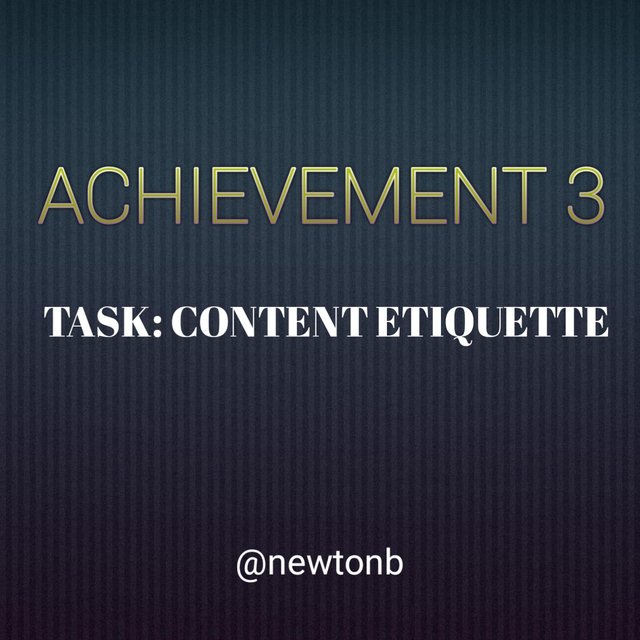ACHIEVEMENT 3 TASK: CONTENT ETIQUETTE BY @newtonb
Hello the Steemit world! I'm glad to bring to you another achievement post of mine. This time I bring you achievement 3 after going through Achievement 1 and Achievement 2 posts successfully. According to Wikipedia Plagiarism is the representation of another author's language, thoughts, ideas, or expressions as one's own original work. In educational contexts, there are differing definitions of plagiarism depending on the institution. Plagiarism is considered a violation of academic integrity and a breach of journalistic ethics. It is subject to sanctions such as penalties, suspension, expulsion from school or work, substantial fines and even imprisonment. According to Oxford Plagiarism is presenting someone else’s work or ideas as your own, with or without their consent, by incorporating it into your work without full acknowledgement. All published and unpublished material, whether in manuscript, printed or electronic form, is covered under this definition. Plagiarism may be intentional or reckless, or unintentional. Under the regulations for examinations, intentional or reckless plagiarism is a disciplinary offence. So generally from the above definitions, I have come to the conclusion that plagiarism is simply copy and pasting from another authors content without appropriate citations and of course this is a crime and is not allowed in content creation. 7 types of plagiarism With this type of plagiarism, the work of someone else is simply paraphrased without proper citation. It’s often difficult to detect because the plagiarized material is interwoven with many different sources, including the writer’s own ideas and perspective. Paraphrasing, or incremental plagiarism, is the most common type of plagiarism. It’s similar to the mosaic plagiarism style mentioned above. However, the difference is that the copied work isn’t mixed in with new concepts and research. When you paraphrase the original idea in your own words, the borrowed material stays the same throughout the new piece. Complete plagiarism is more common in academic writing than in content marketing or other types of online writing. This type of plagiarism occurs when someone tries to submit an entire research paper as their own without proper attribution. Also known as auto-plagiarism, self-plagiarism happens when you copy your own writing, whether intentional or not. Often the person in a self-plagiarism incident is summarizing or repurposing their own work instead of writing a whole new piece from scratch on the same topic. Plagiarism doesn’t always happen on purpose. It’s still considered plagiarism when someone copies another’s writing without citing their source, improperly cites the source or leaves out quotation marks on accident. Just because the omission or incorrect citation was accidental doesn’t mean plagiarism hasn’t been committed. This is why it’s important to check any work and when in doubt, give your source credit. This type of plagiarism refers to instances when misleading sources are involved. For example, the writer may have two sources of information but only reference one. Another form of source-based plagiarism would be when an author quotes a non-existent or incorrect source. Direct plagiarism, also known as verbatim or copy-paste plagiarism, is an intentional and unethical form of stealing content. As the name suggests, the writing is stolen word for word and pasted into the new piece. The author then tries to pass off the content as their own. A word or two might be changed, but this type of plagiarism is too blatant to be considered paraphrasing. a) Ignorance: most people may have little knowledge on the topic they want to talk about and so the only way for them to write is to copy another authors work A citation is the way you tell your readers that certain material in your work came from another source and gives your readers the information necessary to find that source again. Source It's here that I come to the end of this post thank you for reading through. Cc,
WHAT IS PLAGIARISM?

Photo SourceTYPES OF PLAGIARISM Reference
In this section, we’ll cover the 7 most common types of plagiarism:1. MOSAIC OR PATCHWORK PLAGIARISM
This type of paraphrasing can be done from one or several sources. The writer may try to change up the sentence structure or use synonyms to make it seem original. However, taking the idea of another piece is still plagiarism, even if the words are switched up a bit and intermingled with original thought.2. PARAPHRASING PLAGIARISM
3. COMPLETE PLAGIARISM
For example, this involves copying and pasting the original work in its exact words. The only thing that is changed is the author’s name.4. SELF-PLAGIARISM
Many people think self-plagiarism is harmless because you aren’t stealing from someone else. Just yourself. But, this type of plagiarism can be just as damaging as any other.
For example, if you are writing web pages and you are caught plagiarizing, you could end up getting penalized by Google for duplicate content.
Or, if you are writing for clients, your words may no longer belong to you. This could even result in potential legal issues if it is a breach of your client contract.5. ACCIDENTAL PLAGIARISM
6. SOURCE-BASED PLAGIARISM
The worst type of this kind of plagiarism is when sources are fabricated. Making up information like study findings or statistics is extremely misleading and can even be harmful in the case of medical content.7. DIRECT OR VERBATIM PLAGIARISM
CAUSES OF PLAGIARISM
b) Fear of rejection (low self esteem) not being confident of your own work.
c) Laxity not being serious with the topic you are writing about brings about laziness to put in enough work.HOW TO AVOID PLAGIARISM
3)Read others content with the intention to understand and not just to copy.
4)Do enough research and findings in other to be literate enough about your topic.What is a citation?
Remark
"I have read and understood the Steemit Etiquette on Steemit Community and will do my best to embrace them"

@newtonb
I understand you believe your is cited, but this achievement task expect you to work on tour understanding. Copy of content from other sources is the encouraged.
Edit your work
Thank you sir but I have not clearly understood what you exactly you want me to edit.
Can you please help me know exactly what is wrong with the post so that I can edit it? Thanks
Greetings sir @fombae please I have done the necessary editing as you said to the best of my knowledge. Thank you will be waiting for your feedback
Hi, @newtonb,
Your post has been supported by @tarpan from the Steem Greeter Team.
Thank you so much